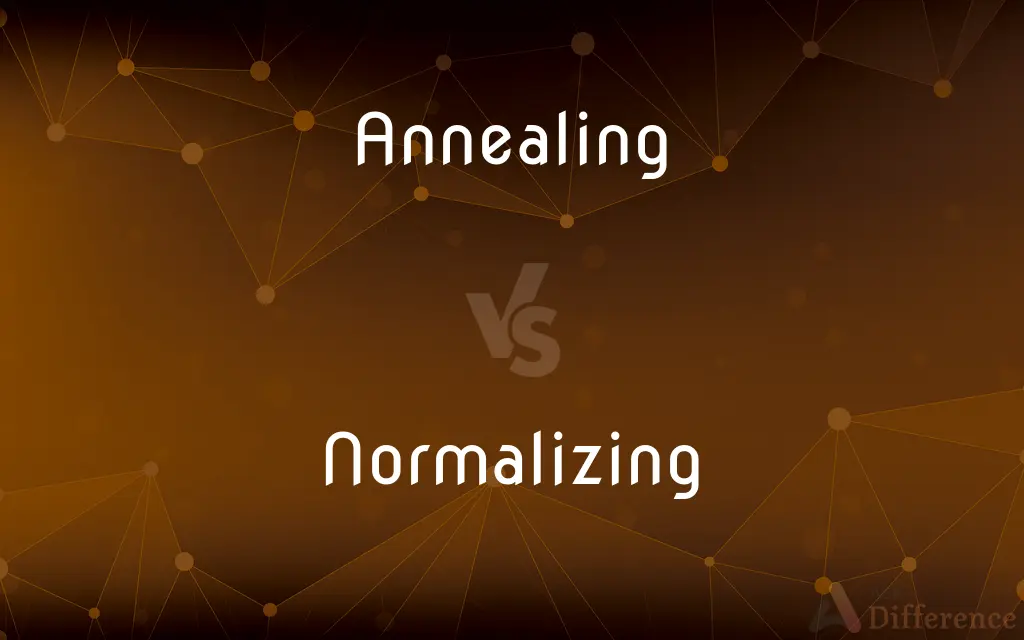Annealing vs. Normalizing — What's the Difference?
By Tayyaba Rehman — Updated on September 21, 2023
Annealing and normalizing are both heat treatments for metals. Annealing softens metal and removes stresses, while normalizing refines and homogenizes grain size and improves mechanical properties.

Difference Between Annealing and Normalizing
Table of Contents
ADVERTISEMENT
Key Differences
Annealing and normalizing are processes used in metallurgy to treat and modify the properties of metals. Annealing involves heating metal to a specified temperature and then cooling it slowly. The primary purpose is to soften the metal, improve its ductility, and reduce its internal stresses.
Normalizing, on the other hand, involves heating the metal and then allowing it to cool in open air. The main aim is to refine the grain size, leading to a more uniform and desirable metal structure. This can result in improved mechanical properties.
In the annealing process, the slow cooling rate is vital as it facilitates the movement of atoms, resulting in a more regular crystalline structure. By doing this, annealing can remove defects and improve the metal's machinability.
With normalizing, the faster cooling in air produces a more refined grain structure than annealing. This difference in cooling rate leads to harder and stronger metals in normalizing than in annealing.
Both annealing and normalizing play crucial roles in preparing metals for further processing, like machining or forming. While they share some similarities, their distinct processes and outcomes cater to different metallurgical needs.
ADVERTISEMENT
Comparison Chart
Purpose
Softens metal, improves ductility, reduces internal stress.
Refines grain size, improves mechanical properties.
Heating
Metal is heated to a specified temperature.
Metal is similarly heated to a high temperature.
Cooling Method
Slowly, often in the furnace.
In open air, resulting in faster cooling.
Resulting Structure
More regular crystalline structure.
More refined grain structure than annealing.
Typical Uses
Preparing metal for further processing, improving machinability.
Enhancing strength and toughness of the metal.
Compare with Definitions
Annealing
Heating and cooling metal to refine its structure.
Annealing was essential before shaping the metal piece.
Normalizing
A heat treatment to homogenize and refine grain size.
Normalizing the steel improved its tensile strength.
Annealing
Enhancing the ductility of a metal.
The rod, after annealing, was easier to bend.
Normalizing
Heating metal and cooling in open air.
After normalizing, the metal exhibited enhanced toughness.
Annealing
A heat treatment that softens metals.
The copper was subjected to annealing to improve its flexibility.
Normalizing
A treatment that results in a uniform structure.
Normalizing ensured that the metal sheet had a consistent grain size.
Annealing
Treatment that improves a metal's machinability.
Annealing was done to ensure smoother machining.
Normalizing
Process to enhance mechanical properties of metals.
The blade underwent normalizing to ensure its durability.
Annealing
To subject (glass or metal) to a process of heating and slow cooling in order to toughen, reduce brittleness, or enhance adhesion.
Normalizing
To make normal, especially to cause to conform to a standard or norm
Normalize a patient's temperature.
Normalizing relations with a former enemy nation.
Annealing
To strengthen or harden.
Normalizing
To cause (something previously regarded as anomalous) to be accepted as normal, thereby altering the accepted norm
“The increased visibility of Iraq War amputees has helped normalize the use of prostheses” (Bruce Barcott).
Annealing
To become strengthened or hardened
“the time she needed for opinion to anneal around her policy” (Alexander M. Haig, Jr.).
Normalizing
To make (a text or language) regular and consistent, especially with respect to spelling or style.
Annealing
The heating of solid metal or glass to high temperatures and cooling it slowly so that its particles arrange into a defined lattice.
Without annealing, the quality of our metal products will diminish.
Normalizing
To remove strains and reduce coarse crystalline structures in (metal), especially by heating and cooling.
Annealing
Present participle of anneal
Normalizing
To become or return to normal
Waiting for diplomatic relations to normalize.
Annealing
The process used to render glass, iron, etc., less brittle, performed by allowing them to cool very gradually from a high heat.
Normalizing
Present participle of normalize
Annealing
The burning of metallic colors into glass, earthenware, etc.
Normalizing
That normalizes
Annealing
Hardening something by heat treatment
Normalizing
Adjusting and stabilizing the properties of metal.
Through normalizing, the inconsistencies in the alloy were reduced.
Annealing
A process to reduce internal stresses in materials.
The glass underwent annealing to prevent it from shattering.
Common Curiosities
What is the primary purpose of annealing?
Annealing primarily softens metals, improves their ductility, and reduces internal stress.
How does the cooling rate in annealing compare to normalizing?
Annealing involves slow cooling, often in the furnace, whereas normalizing cools the metal faster in open air.
Is normalizing always done in open air?
Typically, yes. The open-air cooling distinguishes normalizing from other processes.
Can annealing improve a metal's machinability?
Yes, annealing can enhance a metal's machinability by softening it and refining its structure.
How does normalizing differ in purpose from annealing?
Normalizing aims to refine grain size and enhance the metal's mechanical properties.
Can both processes be applied to all metals?
While many metals can undergo annealing and normalizing, the specific temperatures and results vary by metal type.
How are annealing and normalizing related to other heat treatments?
Both are preparatory or final treatments, but there are other treatments like quenching and tempering that further modify metal properties.
Are the effects of annealing permanent?
While annealing modifies the metal structure, subsequent processes or treatments can further change the metal's properties.
Why might a metal undergo both annealing and normalizing?
Depending on the desired properties, a metal might undergo both to benefit from the combined effects.
Why is the grain structure important in metallurgy?
Grain structure influences many metal properties, including strength, ductility, and resistance to wear and corrosion.
Which process typically results in a harder metal?
Normalizing generally results in harder and stronger metals than annealing.
Does annealing always occur in a furnace?
While often done in a furnace, annealing can also occur in other controlled environments.
Can normalizing help in removing impurities in metals?
While it refines grain size and structure, normalizing doesn't directly remove impurities.
Which process is more energy-intensive?
Both processes require heating the metal to high temperatures, but the energy used can vary based on the specific metal and treatment duration.
Do annealing and normalizing change the metal's chemical composition?
No, they modify the physical properties without altering the chemical composition.
Share Your Discovery

Previous Comparison
Cent vs. Penny
Next Comparison
Octopus vs. CalamariAuthor Spotlight
Written by
Tayyaba RehmanTayyaba Rehman is a distinguished writer, currently serving as a primary contributor to askdifference.com. As a researcher in semantics and etymology, Tayyaba's passion for the complexity of languages and their distinctions has found a perfect home on the platform. Tayyaba delves into the intricacies of language, distinguishing between commonly confused words and phrases, thereby providing clarity for readers worldwide.
















































